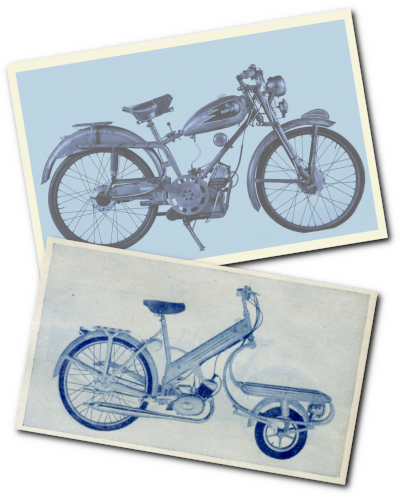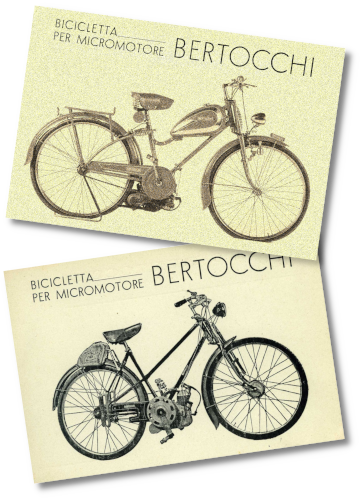This Italian manufacturer is particularly obscure, and proved extremely difficult to find any information about, but we did our best…
As far as we can tell, Arturo Bertocchi started his business as a cycle shop at Via San Vitale 55, Bologna sometime during the 1920s, and he seemed to have progressed to building his own beautiful and highly crafted Superleggera Saetta racing cycles up until Italy’s unfortunate entry into World War II on 10th June 1940.
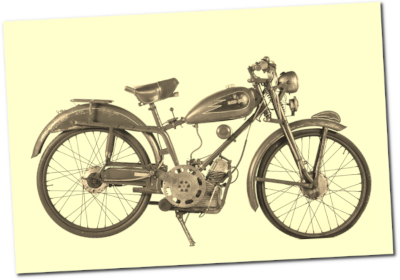
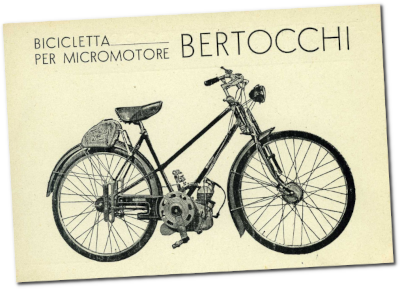
During the immediate post-war period, the recovering Italian economy quickly created a demand for economic transport, and Bertocchi deployed his cycle building experience to start producing ciclomotori frames for mounting Ducati Cucciolo engines. We’ve identified two different types of Bertocchi Cucciolo frames, one dated from its engine serial as 1948 and equipped with swing-arm twin-shock rear suspension, and another frame with plunger rear suspension presented under ‘Pietro Bertocchi’ branding!
Garelli unveiled its sensational new 38.5cc Type 307 Mosquito engine at the Geneva Show in March 1947, and Bertocchi ciclomotori with front and rear sprung frames were subsequently produced to take the Garelli 38.5cc engines, and they were probably offered until Garelli introduced its fairly brief replacement BMG (Bici Mosquito Garelli) 315-model cyclemotor in 1951, now 49cc for 1bhp rating at the same revs.
With lots of Italian manufacturers pouring into the production of personal transport ciclomotori frames, Bertocchi seemingly decided to opt out of competing in this sector around 1950, instead choosing to focus on the more specialised and less contested commercial delivery market, so their catalogue became a comprehensive presentation of trade carriers, tri-porter cycles, and motorised trade cycles.
The pre-war badging subsequently changed to ABB decals (representing Arturo Bertocchi Bologna) in the post-war period and, because of their specialisation, the Bertocchi company would reportedly become better known in this post-war period for its heavy-duty Ciclo trasporto (transport cycles), Furgoncino a pedale (pedal vans), Furgone portata (delivery vans), Furgoncino portata (transport vans), and motorizzato (motorised) derivatives.
As Garelli introduced its third 38-B version of the Mosquito motor in 1953, Bertocchi produced a new cyclemotor to take this, but the frame was now a trade carrier…
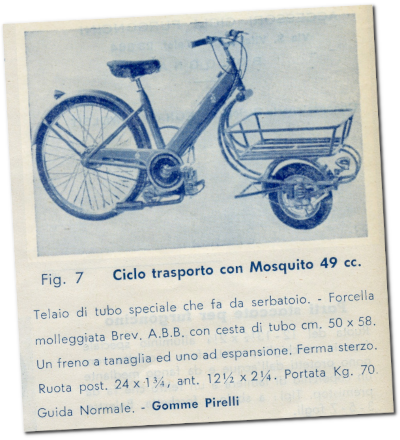
According to the 1958 ABB sales leaflet (the 3-speed Sachs motor only came out in late 1957), our featured machine is titled as a Ciclo trasporto con Mosquito 49cc, and the Fig.7 text translates as ‘Special tubular frame that acts as a fuel tank. Patent ABB suspension fork with tubular basket carrier 50 × 58 cm. One calliper brake and one drum brake. Steering stop. Rear wheel 24 × 1¾, front 12½ × 2¼. Capacity 70kg. Normal steering—Pirelli tyres’.
The frame serial on our featured bike is stamped 330 at the front bottom of the steering headstock and, immediately below this, the fork set is also serial stamped 396 across the welded joint of the stem to the bottom yoke. It makes sense that these serial numbers don’t match up because Bertocchi also sold the fork sets separately to customers wanting to convert existing machines to front-carrier applications.
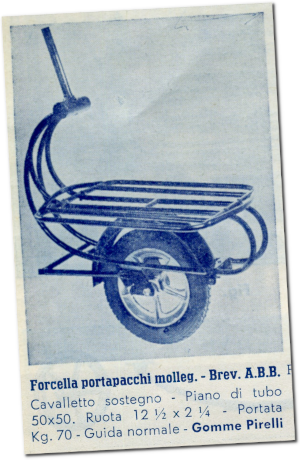
The Fig.6 text Forcella portapacchi molleg - Brev ABB translates as ‘Spring luggage rack fork—Patent ABB Support stand—Tube surface 50 × 50 Wheel 12½ × 2¼, Capacity 70kg’.
A 5-spoke cast aluminium front wheel is fitted with tyre size 12½ × 2¼ (same size as Brockhouse Corgi), so that makes it an 8-inch rim, for which 2.50 width agricultural/mobility tyres are available that will fit, and in a suitably adequate 4-ply construction.
There’s an unusual trailing swing-arm front suspension arrangement with undamped springs each side.
The front forks comprise two double looped tubes welded into a cross tube bottom yoke.
A front stand holds up the bike, but only as long as it’s parked with the front wheel straight ahead, otherwise it keels over like a capsizing battleship, and all your potatoes go rolling down the road…
The front basket is a wattle-weave construction, and treated with some suitable preservative oil, so when we open the workshop in the morning, our nostrils are greeted by the heady aromatic scent … mmm!
The rear tyre is sized 24 × 1¾, so fitting a 20½-inch rim.
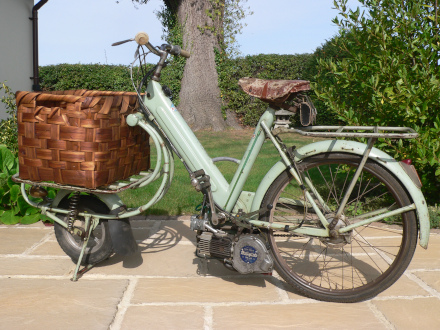
There’s a lifting handle welded into the crook of the frame, but this might seem pointless (unless you’re Hercules), because ABB feels as if the front is welded to the floor. Its weights of 20kg front and 18kg rear don’t represent what actually happens when you try and lift the bike by the handle, as it’s very unbalanced and front heavy, as well as being extremely bulky and clumsy. With a normal cyclemotor the frame handle would lift in balance, but with the ABB this imbalance invalidates its purpose.
Another interesting feature is a large wing-nut protruding from the right-hand side of the frame about halfway down the steering head. Tightening this up makes the steering stiffer to turn, so it’s functioning as a steering damper—which causes us some concern that a cyclemotor might need such a feature, and presents an apprehensive prospect for the coming road test…
Moving on to the cycle frame, it’s one of these tank-in-frame-tube creations, with rigid rear, and a Bakelite moulded fuel cap marked Asate Shellina just behind the steering headstock. While we’ve seen similar frames before on other ciclomotori, we’ve never seen a clear tube connected at top and bottom to the seat tube, which must be joined to the main tank, so petrol in the tube indicates the fuel level!
It’s often very difficult to identify the actual manufacturing source of these various ciclomotori, and while it’s likely the main frame elements were probably produced by some specialist pressworker, the special features (like the steering damper) suggest the components were assembled by Bertocchi.
The rear carrier almost appears to be a proprietary add-on since it seems to utilise a generic type clamp at the saddle end, and the rear stay frame is pivoted through the carrier tube assembly. Also the paint colour doesn’t match the rest of the bike, so while these factors suggest it could be a proprietary rear carrier, we don’t think it is, because the front carrier is also finished in the same paint, and the front carrier is obviously specially made to fit the ABB fork. The conclusion is that the front and rear carriers were specially made and painted by a subcontract source, which used a different batch of unmatched paint…
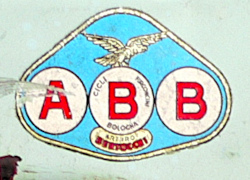
The bike is liberally distributed with the same ABB transfers which show text ‘Cicli Furgoncini Bologna, ABB, Arturo Bertocchi’. Most of the transfers are showing degrees of deterioration after 70 years, leaving just the front mudguard and cycle chaincase decals as practically unblemished.
The Savio saddle appears to be an original Italian sprung mattress cycle seat, with horsehair matting beneath the cover, and you can be sure that’s probably going to be as comfortable as it sounds.
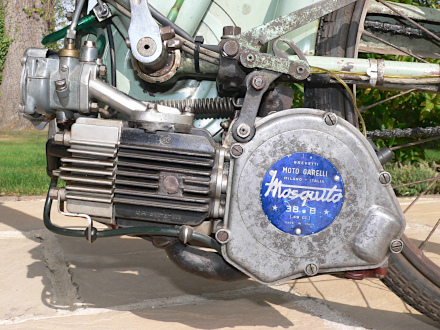
Our ABB is powered by a Garelli Type 38-B Mosquito cyclemotor engine, which Garelli introduced in 1953 as its third version of the Mosquito motor. The first version was the Type 307 38.5cc clip-on engine in 1947, followed by the fairly brief BMG (Bici Mosquito Garelli) 315 model in 1951. The 38-B version of the Mosquito employed the preceding BMG 315 engine, but omitted the internal reduction gear, so the drive roller located directly on the crank journal. It was also increased to 40mm bore × reduced 39mm stroke now resulting in a 49cc under-square specification for a higher 1bhp rating at the same revs.
Despite a compression ratio posted at just 5.5:1, the 38-B motor still quoted the same 1bhp, but re-rated at a lowly 2,800rpm, suggesting it could offer improved torque.
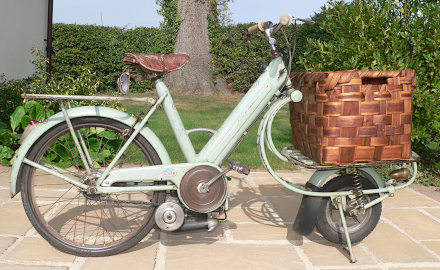
‘Centrimatic’ versions of the 38-B subsequently went on to provide the engines with a centrifugal clutch, which the ABB demonstrates mounted on the right-hand side outboard of the drive roller; this is the first encounter we’ve had with the Mosquito automatic clutch.
Our 49cc Garelli Mosquito 38-B engine carries serial 701109, dates from 1953, and has a cast iron cylinder with an alloy head and direct roller drive. The motor is engaged by means of an over-locking lever set low on the left hand side, switched forward for drive and back for disengage and, because the lever position is inaccessible from the riding position, it’s not possible to use this to provide any clutching function—but with the Garelli Centrimatic clutch, that shouldn’t matter.
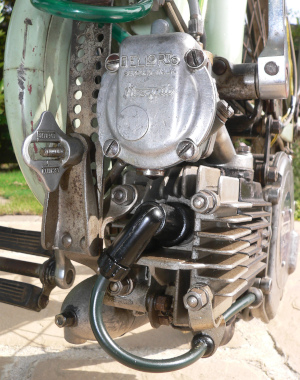
Roller pressure is readily adjustable onto the rear tyre according to the conditions, by screwing a wing nut above and in front of the engine, and indicating its positions as ‘Bagnato–Asciutto’. The wing nut adjusts pre-tension on a coil spring that pulls the engine onto the tyre when the over-locking lever is engaged.
The exhaust looks like an early prototype of some of these curling sport racing expansions you see on modern scooters, sweeping back, then curling forward again, with a cast aluminium cone bolted on the front, with a downward facing outlet.
The engine is equipped with a 10mm Dell’orto ‘Mosquito’ carb specifically made for the Mosquito engine, and operated from an AM cursor-throttle twist-grip. So what’s going on with the rest of the controls, because there’s clearly no brake hub built into the front wheel? We pull on the right-hand brake lever so the cable twitches, and follow its routing around to a cycle style B.A.M. caliper brake mounted below the saddle—hmm! Pull on the left-hand lever so the cable twitches, and follow the routing down to a 90mm alloy brake plate in the half width OMVAL rear hub! OK, so it has two rear brakes, but that’s OK because that still counts as two independent braking systems. There’s another lever below the left-hand handlebar; pull the lever and follow the twitching cable to down below the engine, so that’s the decompressor.
There’s a two-position switch on the handlebar stem, presumably for lights off–on. The cycle headlamp is a 2-inch diameter PBM mounted in front and below the basket and just 12 inches above the road, but does anyone think this lamp might be likely to offer any useful illumination for the rider? We’re going to be hoping we don’t get any dark evening deliveries.
The mudguard mounted rear lamp is marked Brev Sebac Mod. Astor II, and it’s interesting to note a row of six holes along the top left side of the rear mudguard. You’d normally expect such holes to have wires threaded through them to prevent women’s skirts being caught up in the rear wheel, but not in this case because there are no holes on the right-hand side—the wire to the rear lamp is threaded though the holes to keep it away from the tyre.
So, having got some idea of what we’re dealing with, it’s probably time to see if we can get this contraption running…
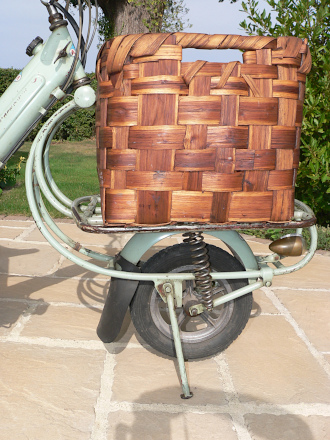
There doesn’t appear to be any fuel indicated in the gauge, so we top up the tank and turn on the tap, but after teasing the flood button we’re not convinced that fuel is getting through, so drain the tank out through the gauge tube, clean out the carb and unblock the tap.
Refilling the tank now finds fuel coming through as the flood button now results in flooding. Inspecting the oily spark plug says time for a clean, so it’s introduced to our plug blaster, then best to test for a spark—but that’s not so easy…
The only way to turn the engine is to engage the roller drive and turn the rear wheel, but because the bike has a front stand, the rear wheel sits on the ground, so you can’t spin it by hand like you might on a bike with a centre stand.
All we can do is to put the plug in the cap, wedge it onto the side of the cylinder head, and wheel the bike along while watching the plug. It’s a difficult way to check for a spark, but yes, we see the plug does blink.
OK, we’re ready to try for a start then, so fuel on, a little tickle on the flood button, set the locking lever forward to engage the roller drive, and pull in the decompressor to pedal away.
Oh, don’t like this. Even with an empty basket the steering is really clumsy and tends to swing side to side and, though the motor pops, bangs, and chugs a little, it doesn’t start, so we return to the workshop to ponder on what to try next.
While pedalling the motor over it sounded somewhat ‘dry’, and maybe felt a bit low on compression, so a conclusion is that it probably hasn’t been run for a very long time, so might take a bit of coaxing.
After recovering from the futile pedalling effort, it was decided to encourage the combustion by heating the top-end of the motor with a hot air gun. Ten minutes later, nice and hot, so: Take 2. Just pedalling down and back up the drive finds the motor running continuously but only at low revs, since the clutch appears to engage very prematurely. Pedalling back down the drive, out through the lane and a trial ride along the road allows the revs to pick up a little, but the handling feels too scary to get up to more than a guesstimated 10mph.
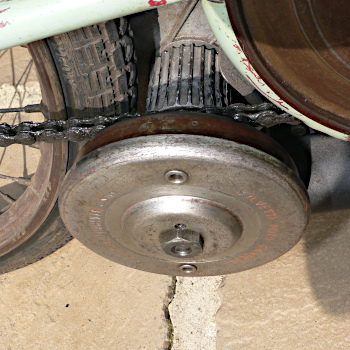
We dread to think what the handling might be like with a ½cwt sack of potatoes loaded (for those unfamiliar with this traditional Imperial weight measure, that’s half a hundredweight = 56lbs = 25kg). We return to the workshops again and see if we can tweak the steering damper to try and improve the handling, and maybe see if we can clean out the clutch … tomorrow.
The clutch drum and shoe linings turned out to be covered in grease, so we wash them off with petrol and rough up the surfaces with sandpaper, then trim the steering damper pressure while cycling up and down the drive. It’s hard to tell if this might improve the handling—we’ll just have to try it out.
Fuel on, flood the carb, set the locking lever forward to engage the roller drive, and pull in the decompressor to pedal away. The motor pops as the decomp drops, but doesn’t respond to throttle, decompress again in and out, another pop, and the motor slowly chugs to life. Cruising gently up and down the drive and along the lane a few times to get the feel of the bike, we decide to back off the damper pressure a little more to reduce steering over-correction problems, which reduces swerving tendencies.
The Centrimatic clutch starts to engage at low revs, but the motor is un-fazed since it capably pulls from tickover revs. Clutch operation felt to be a little improved as it now demonstrated less tendency to stick on, so more readily disengaging at low revs, which made tight turns more manageable without stalling.
Now feeling somewhat more confident about riding, and with a fully warmed-up engine, we’re now joined by our pacer for the road test.
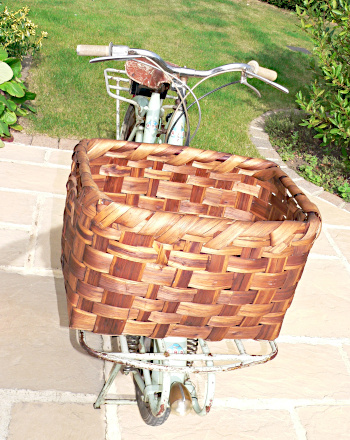
Assisting the engine by light pedalling from down the drive and into the lane, we check back that our shadow is behind as we turn into the road, steadily open the throttle and start to build up speed. The front-end feels quite bouncy when catching some bumps, and small wheels are always twitchy.
Now we’ve run the motor a while, it’s starting to respond to the throttle, and feeling a little more comfortable with the general handling, we open the twist-grip and the Mosquito is starting to feel like it’s getting ready to go—then suddenly loses power and we feel the motor starting to tighten up. There’s nothing you can do about a heat seizure on a direct driven cyclemotor, there’s no clutch to pull in, and snapping back the throttle only suddenly shuts off the fuel and air supply so exacerbates the situation. All you can really do is ease the throttle back lightly to minimise the effect.
Seeing we have problems, our pacer overshoots, and continues down the road to turn around further on, meanwhile we pull up on the side, set the locking lever back to disengage the roller drive, and start walking the bike back to base. Our pacer pulls over on the way back and looks questioningly across the road, ‘The engine nipped up, heat seizure’. It’s only a short walk back to the workshops, less than 10 minutes, and while walking up the drive we wonder if it’s freed off yet? So set the locking lever forward to engage the roller drive, decomp, pedal up the drive, the engine turns over, drop the decomp… and it starts right away. We do a couple of turns up and down the drive, and it’s already like nothing happened.
Our pacer reports clocking 24mph, and it never got up to full speed, so there was certainly more potential in the motor, but there’s no point in trying again if it’s just going to nip up again at 24mph.
The motor top-end needs checking out before more serious running.
Our ABB’s 38-B engine exceeded the 23mph best of the last 38-B we tested in 2019, which we felt wasn’t a capable performer at the time. Maybe another 38-B test might be required.
Further references suggest that the business continued into the 1960s, still listed from the original address as Arturo e Pietro Bertocchi of Via San Vitale 55 Bologna, and a 1960 advert showing bicycle accessories and pedal carts from the same address.
We haven’t been able to trace any of these ‘references’, and the last dated reference we’ve managed to identify is the 1958 ABB sales leaflet, so IceniCAM would really appreciate if anyone may have any further ABB references.
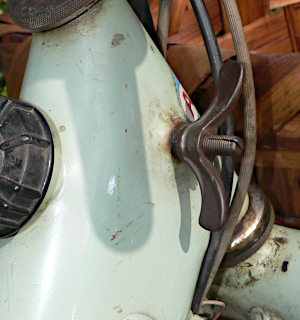
Footnote: Steering damper?
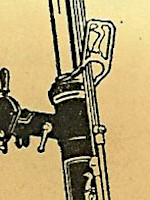
‘Another interesting feature is a large wing-nut protruding from the right-hand side of the frame about halfway down the steering head. Tightening this up makes the steering stiffer to turn, so it’s functioning as a steering damper’—or is it? There's another possibiliy. As also noted in the article, ‘A front stand holds up the bike, but only as long as it’s parked with the front wheel straight ahead, otherwise it keels over like a capsizing battleship’. Tightening the wing-nut when you park the bike, particularly on uneven ground, will lock the steering and make it less likely to fall over.
A similar device used to be fitted to better quality bicycles; the picture on the left shows the steering lock on a 1930 Raleigh. Tighten it up and you could lean the bike against a wall with no fear of it ending up in a heap on the ground.


